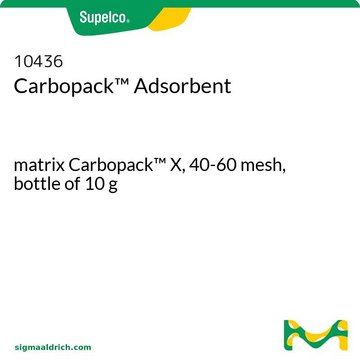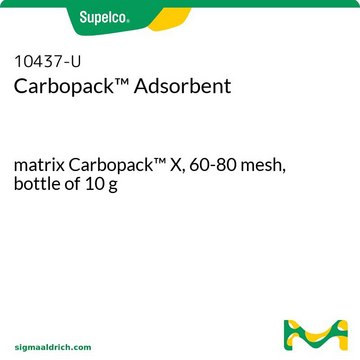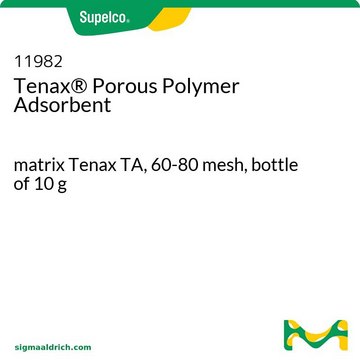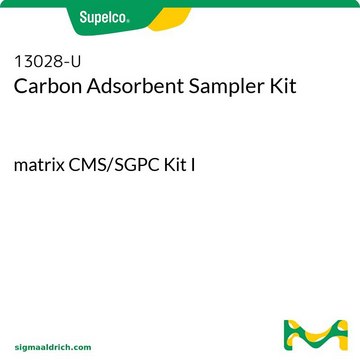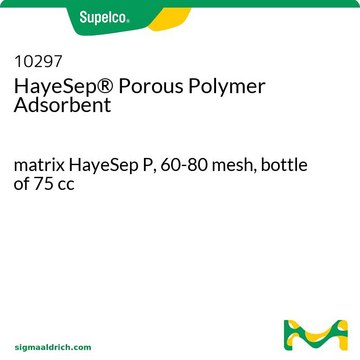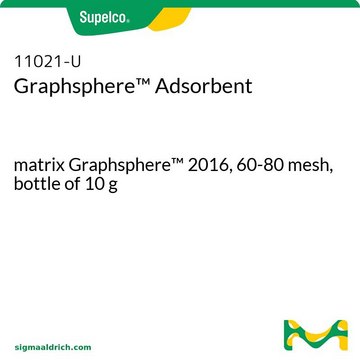20273
Carbopack™ Adsorbens
matrix Carbopack™ B, 60-80 mesh, bottle of 10 g
About This Item
Empfohlene Produkte
Produktlinie
Carbopack™
Form
granular
Verpackung
bottle of 10 g
Methode(n)
LPLC: suitable
Oberflächenbereich
~100 m2/g
Matrix
Carbopack™ B
Aktive Matrixgruppe
carbon
Partikelgröße
60-80 mesh
Porengröße
~0 cm3/g macroporosity
~0 cm3/g mesoporosity
~0 cm3/g microporosity
~0 Å pore diameter
Dichte
~0.38 g/mL (free fall density)
Trenntechnik
reversed phase
Suchen Sie nach ähnlichen Produkten? Aufrufen Leitfaden zum Produktvergleich
Allgemeine Beschreibung
- Granulär
- Bröckelnd
- Wird verwendet für Moleküle mit einer von C3-C20+ n-Alkanen abhängigen Analytgröße
- Hydrophob (kann in Umfeldern mit hoher Luftfeuchtigkeit eingesetzt werden)
GCB-Adsorbentien bieten generell eine geringere relative Adsorptionskraft als Kohlenstoff-Molekularsiebe (CMS) und eine ähnliche relative Adsorptionskraft wie perlförmige Adsorbentien aus graphitisierter Polymerkohle (SGPC). Unsere Carbopack-Produkte sind eine Art von GCB-Adsorbentien.
- Die Partikel haben eine Korngröße von maximal 40 Mesh
- Zur Vermeidung von Channeling eine Korngröße von 40/60 Mesh wählen (falls beobachtet bei Carbotrap® Adsorbentien mit 20/40 Mesh)
- Für alle anderen Anwendungen eine kleinere Korngröße (60/80, 80/100 Mesh usw.) verwenden
- Die kleinste verfügbare Partikelgröße wählen, solange die Anwendung dem Druckabfall standhält
Weitere Informationen über unsere speziellen Kohlenstoffadsorbentien finden Sie auf www.sigma-aldrich.com/missionsirna
Rechtliche Hinweise
Lagerklassenschlüssel
11 - Combustible Solids
WGK
nwg
Flammpunkt (°F)
Not applicable
Flammpunkt (°C)
Not applicable
Persönliche Schutzausrüstung
Eyeshields, Gloves, type P3 (EN 143) respirator cartridges
Hier finden Sie alle aktuellen Versionen:
Analysenzertifikate (COA)
Die passende Version wird nicht angezeigt?
Wenn Sie eine bestimmte Version benötigen, können Sie anhand der Lot- oder Chargennummer nach einem spezifischen Zertifikat suchen.
Besitzen Sie dieses Produkt bereits?
In der Dokumentenbibliothek finden Sie die Dokumentation zu den Produkten, die Sie kürzlich erworben haben.
Kunden haben sich ebenfalls angesehen
Artikel
Carbon Molecular sieves (CMS) are a versatile range of adsorbents that can be tailored for specific applications. Supelco® scientists have been synthesizing synthetic CMS carbons for several decades, starting from tailoring of the starting polymers/copolymers, to modifying the final properties of the subsequent CMS carbon.
Unser Team von Wissenschaftlern verfügt über Erfahrung in allen Forschungsbereichen einschließlich Life Science, Materialwissenschaften, chemischer Synthese, Chromatographie, Analytik und vielen mehr..
Setzen Sie sich mit dem technischen Dienst in Verbindung.
